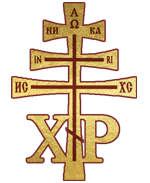This is a title of the Prince-Bishop of Rome-Ruthenia. The full version is Pope-Catholicos of Rome-Ruthenia. In 2014, the head of what is now known as the United Roman-Ruthenian Church was recognized by the Roman Cardinal Dean as Coadjutor of the Roman Pope with full papal authority within his own jurisdiction. This was kept private until Christmas 2019, when the fullness of the Prince-Bishop's office slowly began to be revealed to the public in the 10th year of his ecclesiastical reign, which began in 2020, with full revelation in 2025.
The title “Pope” (from the Greek pappas, meaning father) historically signified not simply jurisdiction over Rome, but the vocation of apostolic guardianship. Similarly, “Catholicos” in the East denoted universal episcopal headship within autonomous Churches. Both titles predate centralization and carry with them the responsibility of transmitting the Apostolic faith intact. The title of Pope for a Patriarch was seen in Alexandria before Rome, and both the Coptic and Byzantine/Greek Patriarchs of Alexandria today hold this title.
It is noted also that, following the division of East and West, and most especially after the Second Vatican Council, the Roman papacy embraced increasingly modern approaches, leading to shifts in doctrinal emphasis and a redefinition of its temporal and spiritual role. Today, the traditional understanding of the papal office lies largely dormant within Roman Catholicism.
The Prince-Bishop stands as a recognized spiritual successor in substance to Roman See, even if not by formal Roman canonical claim. Indeed, the Prince-Bishop as Roman-Ruthenian Pope makes no claims to the Roman Papacy, the Vatican, or the spiritual leadership of the Roman Catholic Church.
This title carries significant theological weight, implying not simply service, but a participation in the Petrine ministry with an orientation toward continuity and succession. The use of the papal and patriarchal title within the Roman-Ruthenian Church and State, i.e., Pope-Catholicos of Rome-Ruthenia, is neither an act of rivalry nor of imitation. Rather, it is a fulfillment of abandoned responsibilities, and a documented recognition of the Roman-Ruthenian Church and State's role as a guardian of the Apostolic and Imperial legacy of Rome and Ruthenia, and therefore of Christendom.
The most formal style of the Prince-Bishop is His Apostolic Highness the Most Holy. That may be shortened to His Apostolic Highness, but never merely to Highness. The shortened form is, rather, His Holiness.
Read more on this page.
Return to Main Page

Pontifical Imperial State
of Rome-Ruthenia
United Roman-Ruthenian Church